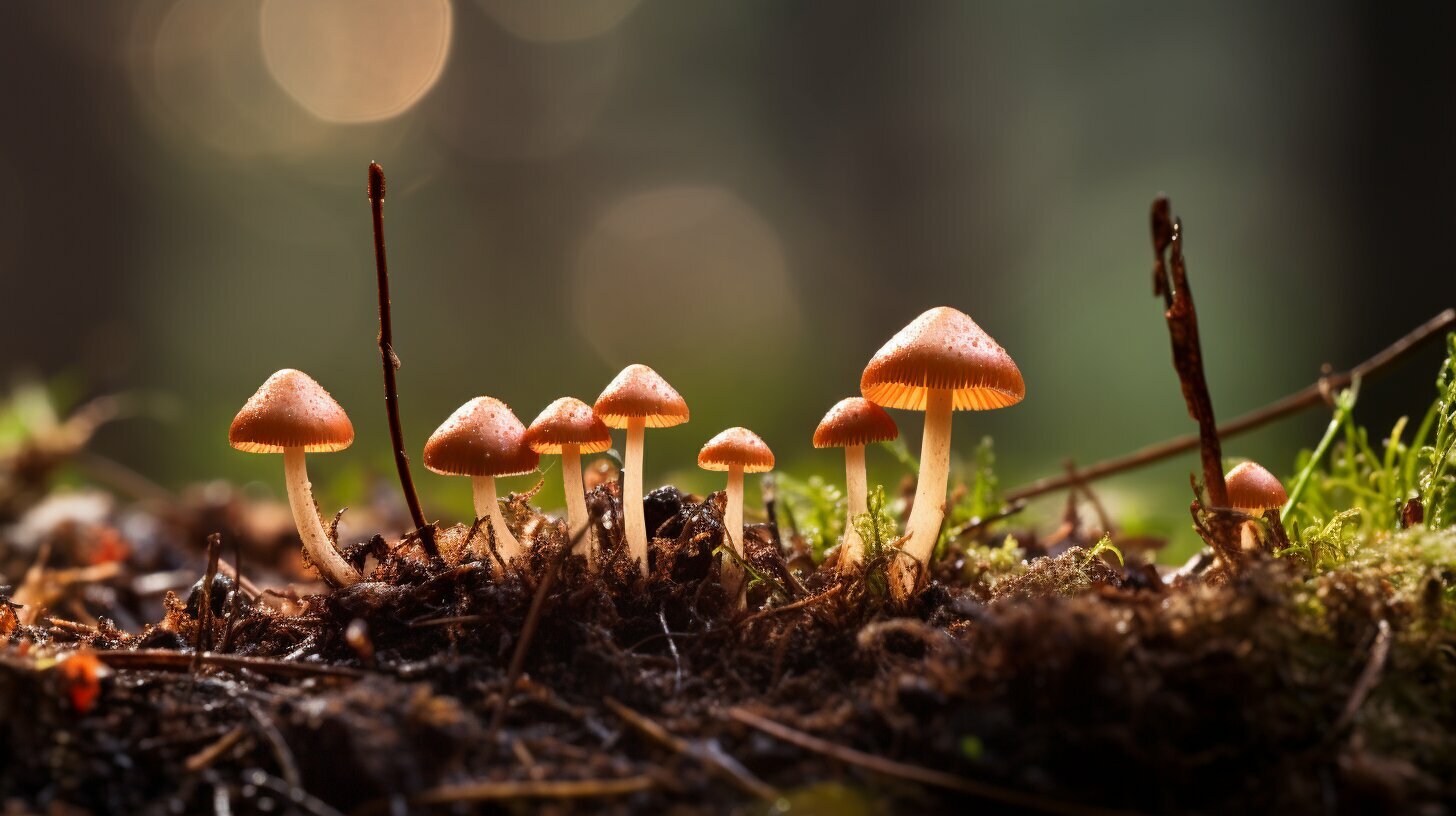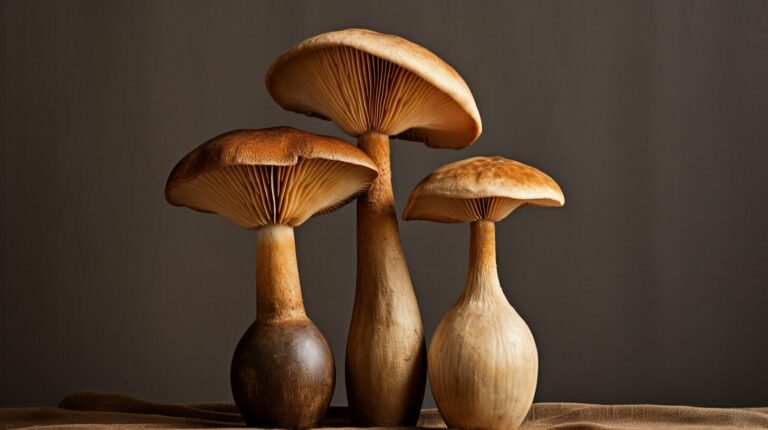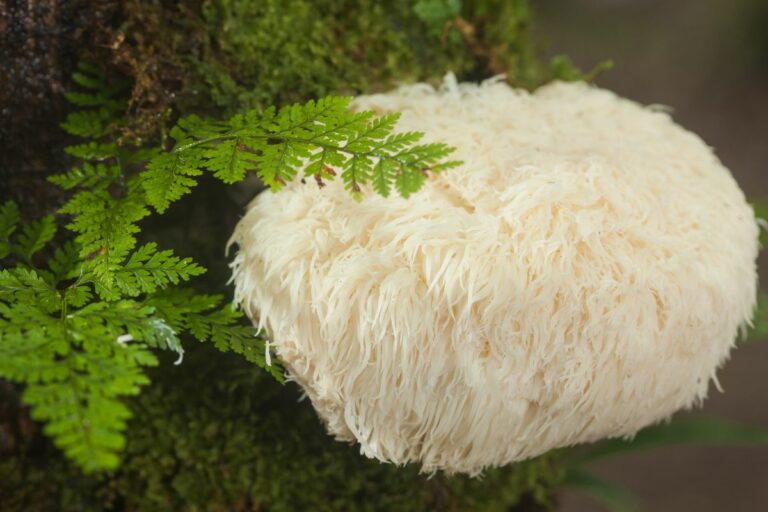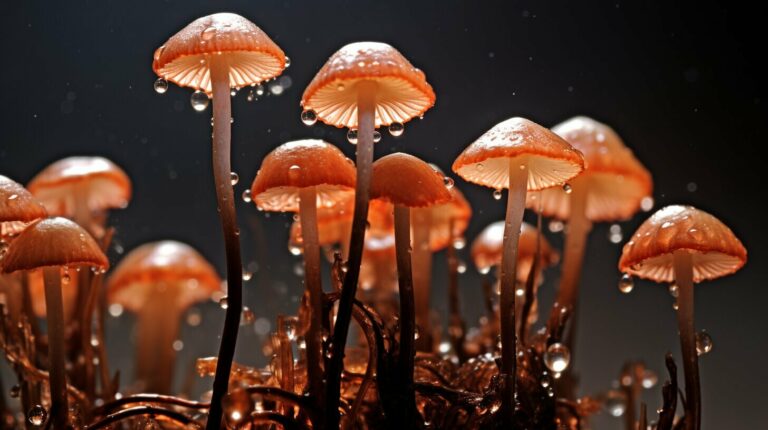The mushroom life cycle is a captivating journey that encompasses various stages of growth and reproduction. It begins with the formation of spores on the basidia, which are microscopic structures found on the underside of mushroom caps. These spores serve as the starting point for the mushroom’s life cycle.
Once the spores are released, they have the potential to germinate and form mycelium. Mycelium is a network of thread-like structures that acts as the foundation for the mushroom’s growth. It expands and absorbs nutrients from its environment, allowing the mushroom to develop and thrive.
As the mycelium matures, it undergoes a transformation, developing into small structures called primordia. These primordia are the baby mushrooms and mark the transition from mycelium to fully-grown mushrooms.
With time, the primordia continue to develop, growing into fully-grown mushrooms. These mature mushrooms go on to release spores, completing the life cycle. The released spores then have the potential to start the cycle anew.
Understanding the life cycle of mushrooms is essential for their cultivation and appreciation. Cultivating mushrooms involves preparing a suitable substrate, inoculating it with mushroom spores or mycelium, and providing optimal conditions for growth. By knowing the different stages of the life cycle, growers can effectively nurture mushrooms and ensure a successful harvest.
Mushrooms play a vital role in ecosystems. They act as decomposers, breaking down organic matter and returning nutrients to the soil. They also form symbiotic relationships with plants, enhancing their growth and vitality. Additionally, mushrooms serve as food sources for numerous wildlife species, contributing to the biodiversity of ecosystems.
The mushroom life cycle exemplifies the unity and interconnectedness of the natural world. It reminds us of the intricate web of life and our place within it. By studying and appreciating the life cycle of mushrooms, we gain a deeper understanding of the complexities and beauty of our own existence.
- The mushroom life cycle begins with the formation of spores on the basidia.
- Mycelium serves as the foundation for the mushroom’s growth.
- Primordia are the early stage mushrooms that develop from mycelium.
- Fully-grown mushrooms release spores to complete the life cycle.
- Understanding the life cycle is crucial for mushroom cultivation and appreciation.
The Formation of Mushroom Spores
Table of Contents
The mushroom life cycle begins with the formation of spores on specialized structures called basidia. These basidia are found on the gills or pores of a mushroom’s cap. As the mushroom reaches maturity, these basidia release spores into the surrounding environment. The spores are tiny, often invisible to the naked eye, and are carried by wind, water, or animals to new locations, where they have the potential to germinate and give rise to new mushrooms.
Spores are vital for the reproduction and survival of mushrooms. They are the equivalent of seeds in plants, carrying the genetic information necessary for the development of a new mushroom. Each spore has the potential to grow into a new mycelium, which is the vegetative part of the mushroom that consists of a network of thread-like structures.
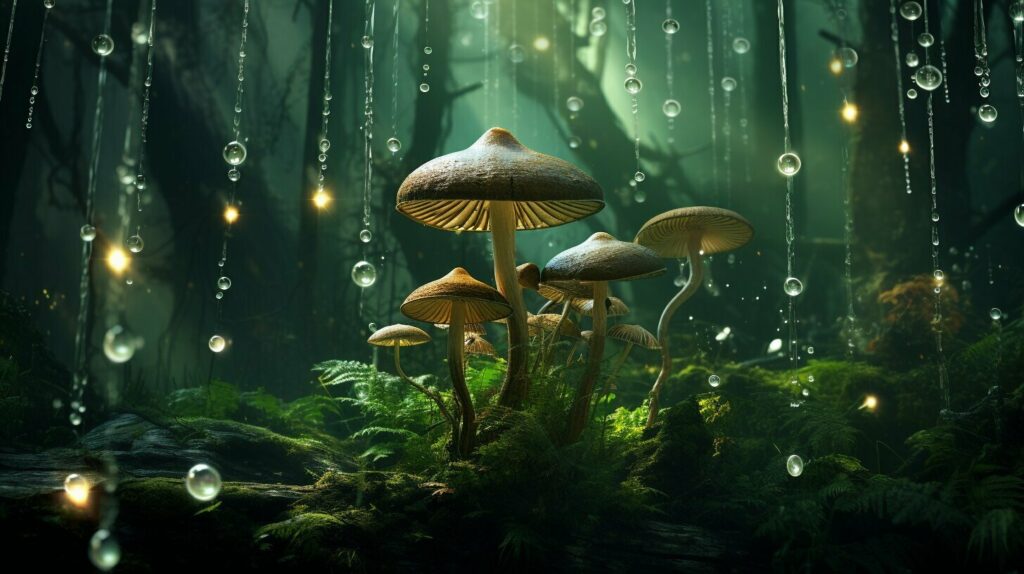
The spores of mushrooms are incredibly diverse, exhibiting various shapes, sizes, and colors. Some spores have unique features such as spines, ridges, or even appendages. These distinguishing characteristics can help identify different mushroom species.
While spores play a critical role in the mushroom life cycle, they are just a small part of the fascinating journey these organisms undergo. From the formation of spores to the maturation of fully-grown mushrooms, each stage offers unique insights into the interconnectedness of the natural world and our own existence.
Germination and Mycelium Formation
Once the spores are released, they germinate and develop into mycelium, creating a foundation for mushroom growth. This process is vital to the mushroom’s life cycle and serves as a crucial stage in its development.
Spore germination occurs when the spores, which are essentially the reproductive cells of mushrooms, encounter favorable conditions such as moisture, nutrients, and suitable temperatures. As the spores absorb water, they begin to swell and break open, initiating the germination process.
The germinated spores give rise to thread-like structures called mycelium. Similar to the roots of a plant, mycelium acts as the main body of the mushroom, extending and branching out beneath the surface of the substrate. It obtains nutrients from its surroundings, breaking down organic matter and converting it into a form that can be absorbed by the mushroom.
The mycelium network plays a vital role in supporting mushroom growth. Under the right conditions, the mycelium develops and spreads, forming a web-like structure that prepares the substrate for the next stage of the mushroom life cycle.
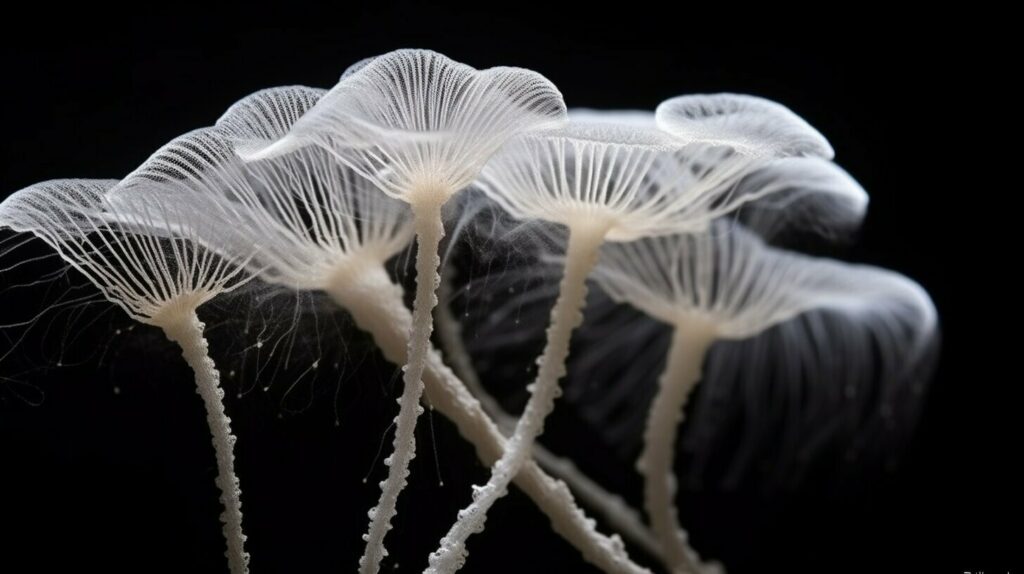
Mycelium is a crucial component in mushroom cultivation. In commercial mushroom production, cultivators utilize mycelium through a process called mushroom spawning. Mushroom spawn, which consists of mycelium growth on a substrate, is used to inoculate various materials such as wood chips, sawdust, or straw.
By introducing mycelium to the substrate, cultivators create an environment conducive to mushroom growth. The mycelium colonizes the substrate, breaking it down and transforming it into a suitable medium for the mushrooms to thrive. This colonization process can take several weeks, during which the mycelium spreads and establishes itself throughout the substrate.
Understanding the role of mycelium in mushroom cultivation is crucial for successful harvests. By providing the proper conditions and optimal growth parameters, cultivators ensure that the mycelium can grow and develop effectively, leading to the formation of primordia and eventually fully-grown mushrooms, completing the fascinating mushroom life cycle.
Primordia Development
As the mycelium matures, it gives rise to primordia, the early stages of mushroom development. These tiny structures are the precursors to fully-grown mushrooms and play a crucial role in the mushroom life cycle. Primordia emerge from the mycelium as small bumps or knots, signaling the transition from vegetative growth to reproductive growth. They are an exciting stage to observe, as they hold the promise of future mushroom growth and eventual spore release.
Primordia formation occurs as a result of a combination of environmental triggers and genetic signaling within the mycelium. Factors such as temperature, humidity, and light can influence their development. The mycelium secretes enzymes that break down the surrounding substrate, providing the necessary nutrients for primordia formation. As the primordia grow, they begin to differentiate into distinct mushroom parts, including the cap, stem, and gills.
During this stage, it is important to provide the primordia with optimal conditions for growth. Maintaining consistent humidity levels and ensuring proper air circulation can help promote their development. It is also crucial to monitor and adjust the temperature to create an environment conducive to mushroom growth. The primordia require patience and care, as they gradually transform from small bumps into recognizable mushroom shapes.
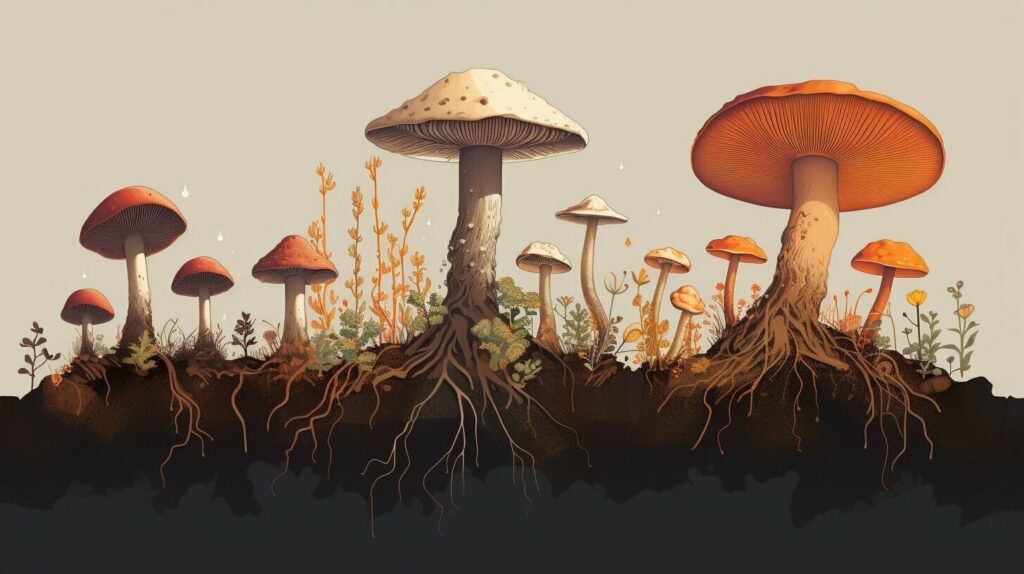
| Stage | Description |
|---|---|
| Spore Formation | Basidia produce spores |
| Germination | Spores germinate, forming mycelium |
| Primordia Development | Emergence of primordia from mycelium |
| Mushroom Maturation | Primordia grow into fully-grown mushrooms |
| Spore Release | Mature mushrooms release spores |
As the primordia develop and grow, they hold the potential to blossom into exquisite and diverse mushroom species. Observing this process not only provides insights into the fascinating mushroom life cycle but also serves as a reminder of the interconnectedness of all living beings in the natural world. From the humble beginnings of spores to the grandeur of fully-grown mushrooms, each stage represents a testament to the beauty and complexity of nature’s processes.
Maturation of Fully-Grown Mushrooms
After a period of growth, the primordia transform into fully-grown mushrooms, ready for the next stage of the life cycle. These mature mushrooms exhibit a wide variety of shapes, sizes, and colors, captivating the eyes of nature enthusiasts and foragers alike. From the classic white button mushroom to the vibrant red-capped Amanita muscaria, each species has its own unique characteristics and flavor profiles.
As the mushrooms reach maturity, their caps expand and their stems elongate, providing support for the reproductive structures within. The gills or pores underneath the caps are responsible for producing and releasing spores, ensuring the continuation of the mushroom life cycle. These spores are microscopic and, once released, are carried away by wind, water, or even passing animals, allowing them to disperse and potentially colonize new habitats.
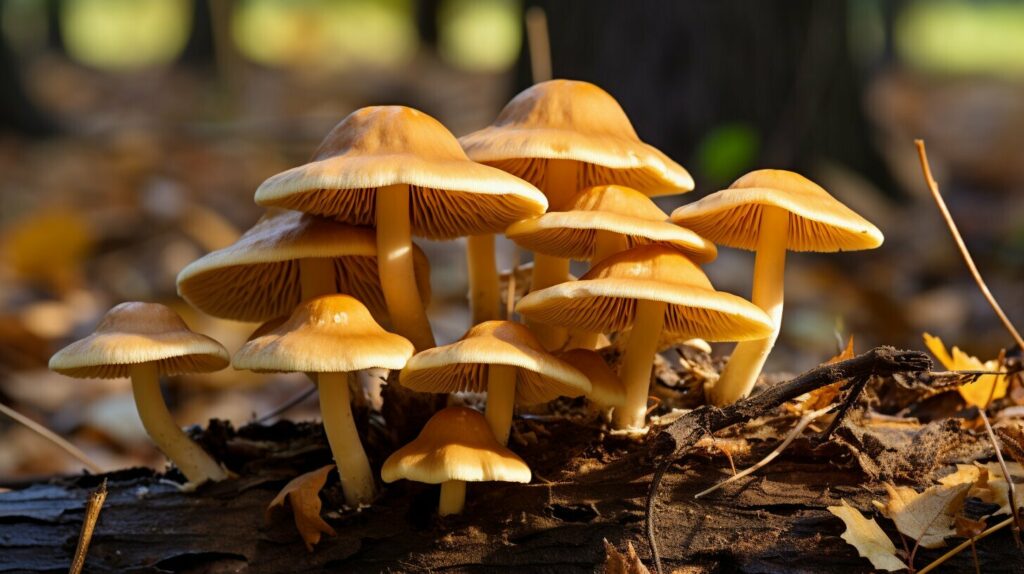
The maturation process of fully-grown mushrooms is a key stage in the mushroom life cycle, representing the pinnacle of their development. It is during this phase that mushrooms display their full potential, both in terms of appearance and reproductive capacity. They are a testament to the intricate and delicate balance of nature, showcasing the wonders of life.
Characteristics of Fully-Grown Mushrooms:
- Varying shapes, sizes, and colors
- Expanded caps and elongated stems
- Distinct gills or pores for spore production
- Microscopic spores released into the environment
The growth and maturation of fully-grown mushrooms exemplify the interconnectedness of the mushroom life cycle with the natural world around us. It serves as a reminder of the unity and diversity that exist in ecosystems, as well as the vital role mushrooms play in sustaining life. From decomposition to symbiotic relationships, these incredible organisms continue to inspire awe and appreciation for the intricate web of life.
Spore Release and Reproduction
Fully-grown mushrooms release spores, facilitating their reproduction and continuation of the life cycle. Spore release is a critical stage in the mushroom’s journey, as it ensures the survival and dispersal of these fascinating organisms. With the release of countless spores into the environment, mushrooms increase their chances of finding suitable conditions for germination and growth.
This process of spore release is often aided by natural factors such as wind, rain, or even animal interactions. The spores, tiny and lightweight, can be carried over long distances, reaching new habitats and colonizing different areas. It is through this method that mushrooms contribute to the dispersal and diversity of fungal populations in various ecosystems.
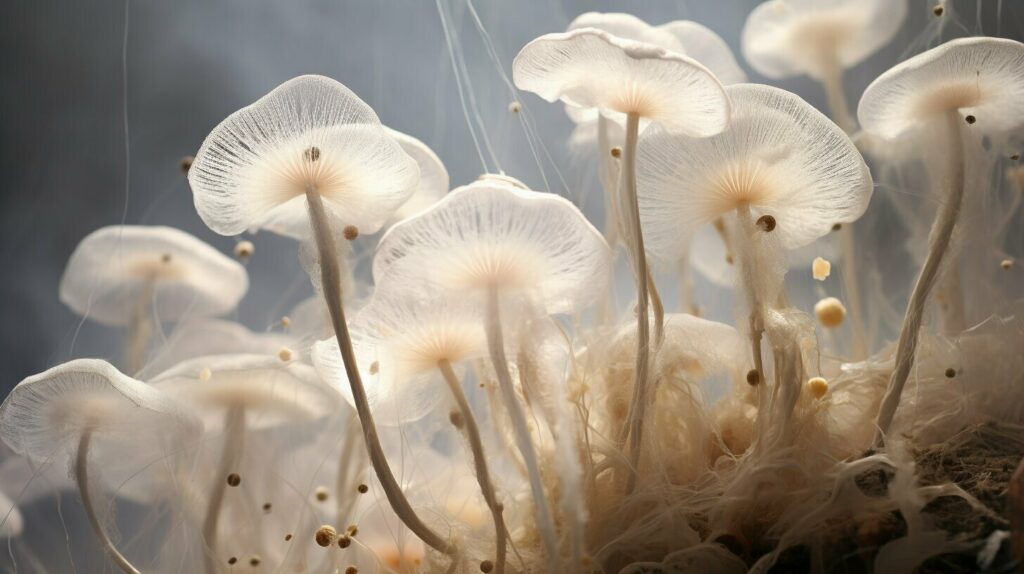
In the intricate web of nature, the spores released by mushrooms also play a crucial role in nutrient recycling and decomposition. As the spores settle onto organic matter, they germinate, giving rise to mycelium, which begins the process of decomposing organic material. This decomposition not only helps break down dead plant and animal matter but also releases vital nutrients back into the soil, supporting the growth of future life forms.
| The Importance of Spore Release and Reproduction |
|---|
| Facilitates reproduction and continuation of the mushroom life cycle |
| Contributes to the dispersal and diversity of fungal populations |
| Plays a crucial role in nutrient recycling and decomposition |
Spore release and reproduction exemplify the interconnectedness of the natural world. It highlights how each organism, like the mushroom, plays a vital role in sustaining ecosystems and maintaining the delicate balance of life. By understanding and appreciating the life cycle of mushrooms, we gain a deeper appreciation for the intricate web of life and our own place within it.
Importance of Understanding the Mushroom Life Cycle
Understanding the mushroom life cycle is vital for both cultivating mushrooms and appreciating their importance in ecosystems. The mushroom life cycle is a fascinating journey that begins with the formation of spores on the basidia and ends with the release of spores from mature mushrooms. These spores serve as the starting point for mushroom growth and development.
Spores germinate and form mycelium, a network of thread-like structures that provide the foundation for the mushroom’s growth. Mycelium plays a crucial role in breaking down organic matter, making mushrooms important decomposers in ecosystems. In addition, mushrooms form symbiotic relationships with plants, aiding in nutrient uptake and improving soil health. They also serve as a valuable food source for wildlife, contributing to the biodiversity of our natural world.
“Mushrooms are nature’s recyclers, breaking down and transforming organic material into vital nutrients for the environment.”
To cultivate mushrooms, it is essential to understand their life cycle. This knowledge allows us to create optimal conditions for growth and harvest. Mushroom cultivation involves preparing a suitable substrate, inoculating it with mushroom spores or mycelium, and providing the right temperature, humidity, and airflow. By following the stages of the mushroom life cycle, we can ensure successful cultivation and a bountiful harvest.
The mushroom life cycle not only provides us with practical benefits but also offers a deeper understanding of the interconnectedness of the natural world and our own existence. Just like mushrooms rely on the environment and other organisms for their growth, we too are part of this intricate web of life. The mushroom life cycle reminds us of the unity and balance that exist in nature, inspiring us to appreciate and protect the ecosystems that sustain us all.
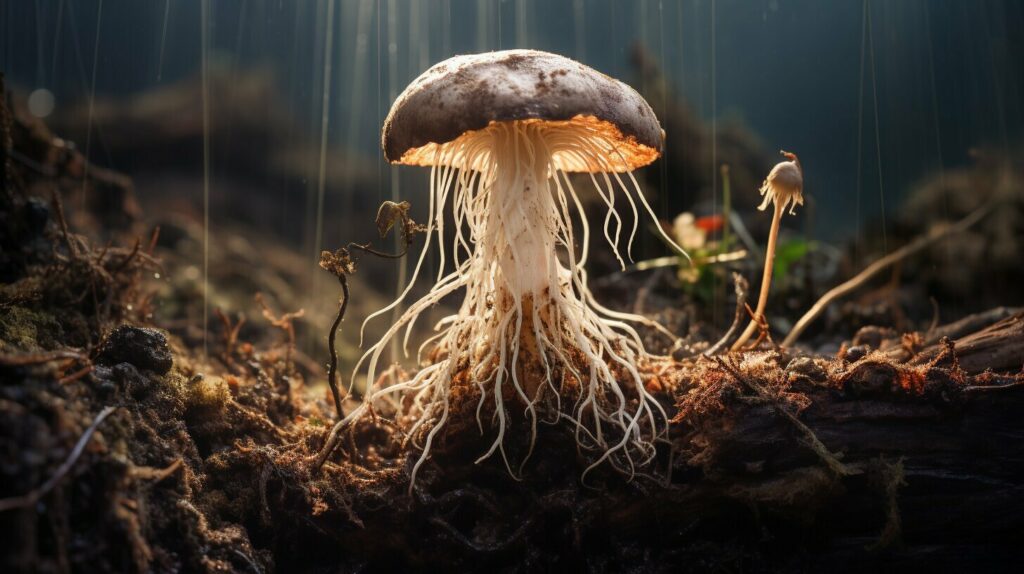
Understanding the mushroom life cycle is a gateway to a world of wonder. It opens our eyes to the remarkable journey that mushrooms undertake, from spores to mature fungi. By cultivating mushrooms and appreciating their importance in ecosystems, we can connect with the natural world on a deeper level, gaining valuable insights into our own existence.
Mushroom Cultivation Process
Cultivating mushrooms involves preparing a suitable substrate, inoculating it with mushroom spores or mycelium, and providing ideal conditions for development. The first step in the cultivation process is selecting the right substrate, which acts as a food source for the mushrooms. Common substrates include straw, wood chips, or composted materials.
Once the substrate is prepared, it is time to inoculate it with mushroom spores or mycelium. Spores are tiny reproductive cells that can be purchased or collected from mature mushrooms, while mycelium refers to the network of thread-like structures that are grown from spores.
Inoculation is typically done by mixing the spores or mycelium with the substrate and allowing them to colonize over time. This colonization process is facilitated by maintaining the substrate at optimal temperatures and humidity levels. It’s important to create a clean and sterile environment to prevent contamination and ensure the growth of healthy mushrooms.
As the mycelium spreads and colonizes the substrate, the next stage of mushroom development begins. Mushroom pins, also known as primordia, will start to emerge. These small structures are the precursors to mature mushrooms. They require specific environmental conditions, such as proper air ventilation and lighting, to continue their growth.
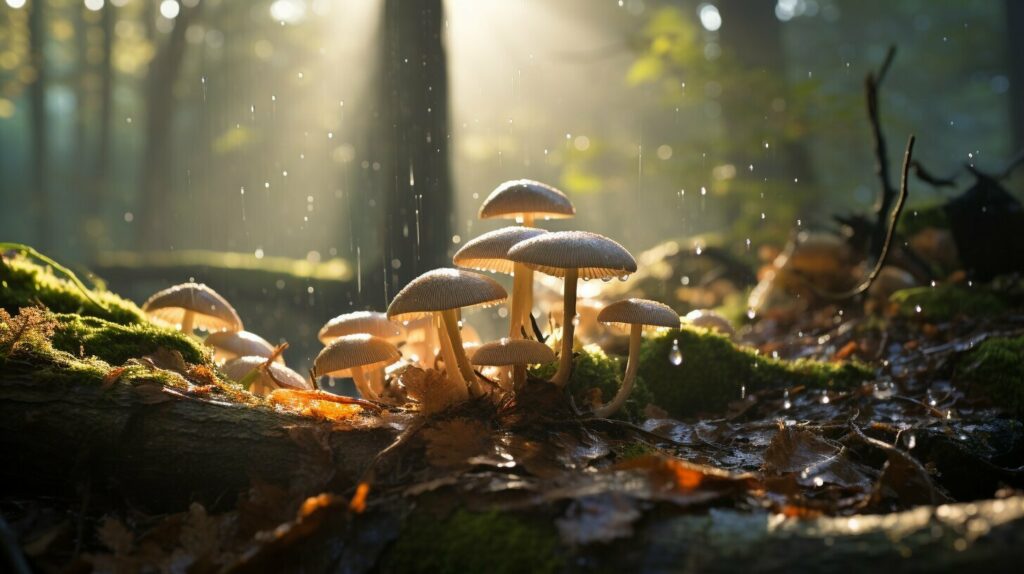
Finally, with the right conditions in place, the primordia will develop into fully-grown mushrooms. This process can take several weeks, depending on the mushroom species. Once the mushrooms reach maturity, they release spores, which can be used to start the cultivation process again.
The mushroom cultivation process is not only fascinating but also provides an opportunity to appreciate the intricate life cycle of these organisms. By understanding the different stages of mushroom growth, cultivators can ensure successful cultivation, while also gaining insight into the interconnectedness of the natural world and our own existence.
The Role of Mushrooms in Nature
Mushrooms play a vital role in ecosystems, acting as decomposers, forming symbiotic relationships with plants, and serving as an essential food source for various wildlife. As decomposers, mushrooms break down organic matter, such as dead plants and animals, and release nutrients back into the soil. This process is crucial for nutrient cycling and the health of the ecosystem. Without mushrooms, the accumulation of organic matter would lead to nutrient imbalances and hinder the growth of new plants.
Symbiotic relationships between mushrooms and plants are also significant. Mycorrhizal fungi, for example, form a mutually beneficial partnership with the roots of plants. The fungus provides the plant with increased access to nutrients, such as phosphorus and nitrogen, while the plant supplies the fungus with sugars produced through photosynthesis. This symbiosis enhances the plant’s ability to grow and adapt to different environmental conditions, making it an essential component of healthy ecosystems.
Furthermore, mushrooms serve as a crucial food source for a wide range of wildlife. Insects, birds, mammals, and even some reptiles rely on mushrooms as a source of nutrition. These organisms play a pivotal role in dispersing mushroom spores, aiding in the reproduction and distribution of fungal populations. Additionally, certain species of mushrooms have medicinal properties and are used in traditional medicine practices.
The Interconnectedness of Life
In exploring the role of mushrooms in nature, we begin to uncover the interconnectedness of life in the natural world. The mushroom life cycle, from spore formation to spore release, demonstrates the cyclical nature of existence. Just as mushrooms rely on other organisms and environmental conditions for their growth and survival, we too are interconnected with the world around us. The delicate balance of ecosystems hinges on the contributions of each living organism, including mushrooms.
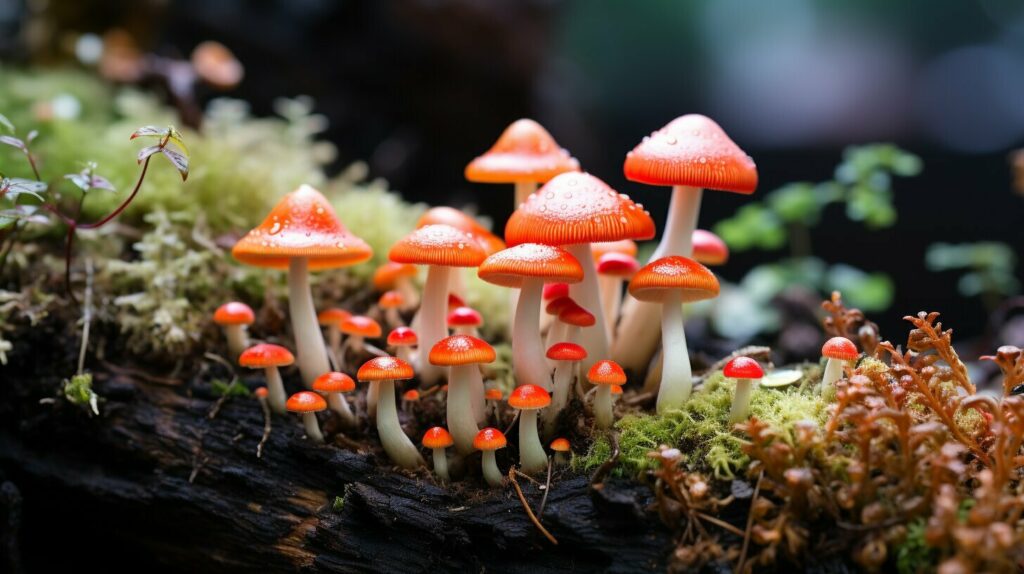
By understanding and appreciating the role of mushrooms in nature, we gain a deeper appreciation for the intricate web of life that sustains us all. Their ability to decompose and recycle organic matter, form symbiotic relationships, and provide sustenance to wildlife reminds us of the interdependence and unity that exist in our own existence. Let us continue to cultivate this awareness and strive to protect the natural world that nurtures and supports us.
| Role | Description |
|---|---|
| Decomposers | Mushrooms break down organic matter and release nutrients back into the soil, vital for nutrient cycling and ecosystem health. |
| Symbiotic Relationships | Mushrooms form mutually beneficial partnerships with plants, enhancing their growth and ability to adapt to different environmental conditions. |
| Food Source | Mushrooms are an essential source of nutrition for insects, birds, mammals, reptiles, and aid in the dispersal of spores. |
Unity and Interconnectedness in the Mushroom Life Cycle
The mushroom life cycle brings about a sense of unity and interconnectedness in the natural world, providing profound insights into our own existence. As we explore the fascinating journey of mushrooms, we begin to understand the intricate web of relationships that exist within the ecosystem. Each stage of the mushroom’s life cycle plays a crucial role in maintaining the balance and harmony of the natural world.
Just like the mycelium, which forms a vast network of thread-like structures beneath the surface, connecting trees and plants, the mushroom life cycle reminds us of the deep interdependence found in nature. It is through this interconnectedness that mushrooms contribute to the health of ecosystems, acting as decomposers and recycling nutrients back into the soil.
“Mushrooms are nature’s recyclers, breaking down organic matter and transforming it into fertile soil.”
The unity within the mushroom life cycle extends beyond its ecological significance. It symbolizes the cyclical nature of existence, where life emerges, grows, and eventually returns to the earth. This unity can be witnessed in the harmonious dance of spores, released by mature mushrooms, drifting through the air and finding their way to new habitats where they can continue the cycle of life.
In contemplating the interconnectedness of the mushroom life cycle, we gain a deeper appreciation for the intricate web of existence that surrounds us. It serves as a reminder that we are all part of a larger whole, connected to the natural world in ways we may not always realize. By nurturing this connection, we can cultivate a greater sense of harmony and respect for the delicate balance of life.
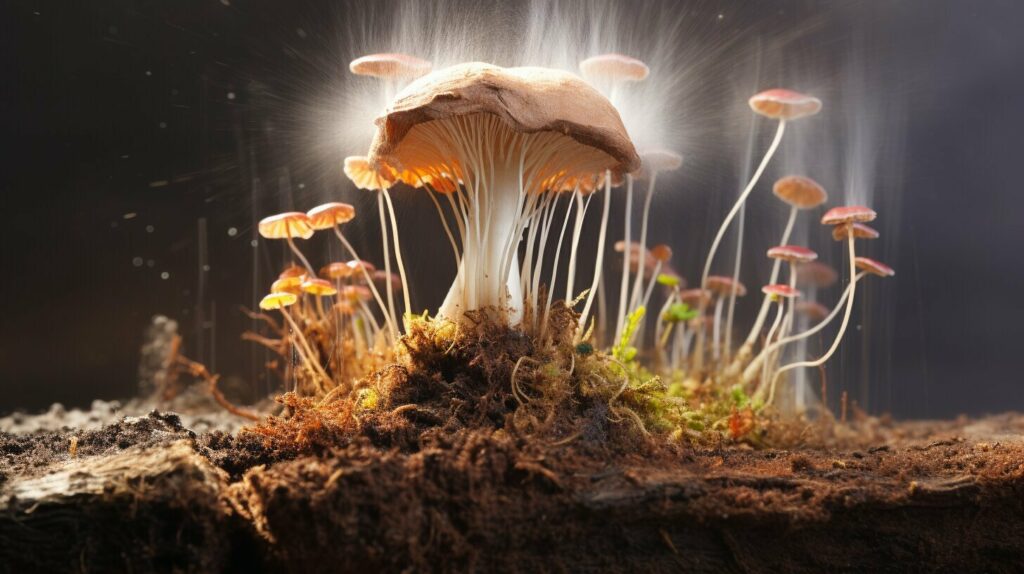
| Mushroom Life Cycle | Key Stages |
|---|---|
| Spore Formation | Formation of spores on the basidia |
| Germination and Mycelium Formation | Spores germinate, forming mycelium |
| Primordia Development | Development of baby mushroom structures (primordia) |
| Maturation of Fully-Grown Mushrooms | Primordia mature into fully-grown mushrooms |
| Spore Release and Reproduction | Mature mushrooms release spores for reproduction |
- Spores are formed on the basidia.
- These spores germinate and give rise to mycelium.
- Mycelium develops into baby mushroom structures called primordia.
- Primordia grow into fully-grown mushrooms.
- Mature mushrooms release spores for reproduction.
With each stage of the mushroom life cycle, we witness the unity and interconnectedness that underpins the natural world. From the formation of spores to the release of new spores, mushrooms exemplify the beauty and complexity of life. By embracing the wisdom found in their life cycle, we can deepen our appreciation for the wonders of nature and our place within it.
Conclusion
In conclusion, the mushroom life cycle is a captivating journey that unfolds from spores to fully-grown mushrooms, highlighting the interconnectedness of nature and its significance in cultivation and appreciation.
Starting with the formation of spores on the basidia, the mushroom life cycle progresses as these spores germinate and give rise to mycelium, a network of thread-like structures that serve as the foundation for mushroom growth. From the mycelium, primordia, or small mushroom baby structures, develop and mature into fully-grown mushrooms.
Once mature, these mushrooms play a crucial role in ecosystems. They serve as decomposers, breaking down organic matter and returning nutrients to the soil. Mushrooms also form symbiotic relationships with plants, aiding in their growth and health. Additionally, they serve as food sources for wildlife, contributing to the balance of the natural world.
Understanding the mushroom life cycle is essential for cultivation, whether for personal enjoyment or commercial purposes. By comprehending each stage, from preparing the substrate to providing optimal growth conditions, growers can successfully cultivate mushrooms and appreciate their unique characteristics.
The mushroom life cycle not only provides practical knowledge but also offers profound insights into our own existence. It reminds us of the unity and interconnectedness present in the natural world. Just as mushrooms rely on various elements to complete their life cycle, our lives are intertwined with the ecosystem around us. We are part of a larger tapestry, where every organism, no matter how small, contributes to the harmony and balance of our existence.
FAQ
Q: What is the mushroom life cycle?
A: The mushroom life cycle is a journey that begins with the formation of spores on the basidia and ends with the release of spores from mature mushrooms.
Q: How do mushroom spores form?
A: Mushroom spores are formed on the basidia, which are specialized structures found in the gills or pores of the mushroom cap.
Q: What happens after spores are formed?
A: The spores germinate and form mycelium, which is a network of thread-like structures that serve as the foundation for the mushroom’s growth.
Q: What are primordia?
A: Primordia are small mushroom baby structures that develop from the mycelium and eventually mature into fully-grown mushrooms.
Q: How do mushrooms reach full maturity?
A: The primordia go through a maturation process and develop into fully-grown mushrooms, ready for spore release.
Q: How do mature mushrooms release spores?
A: Mature mushrooms release spores through various mechanisms, such as the opening of their caps or the release of spore-bearing structures.
Q: Why is understanding the mushroom life cycle important?
A: Understanding the mushroom life cycle is crucial for cultivation and appreciation of these organisms, as well as their role in ecosystems.
Q: How do you cultivate mushrooms?
A: Mushroom cultivation involves preparing a suitable substrate, inoculating it with mushroom spores or mycelium, and providing optimal conditions for growth.
Q: What is the role of mushrooms in nature?
A: Mushrooms play vital roles in ecosystems as decomposers, forming symbiotic relationships with plants, and serving as food sources for wildlife.
Q: What does the mushroom life cycle teach us about the natural world?
A: The mushroom life cycle brings about a sense of unity and interconnectedness in the natural world, offering insights into our own existence.

